The AICTE application status for engineering colleges until 12/31/2008 is at https://www.orissalinks.com/archives/2162. Until then 68 engineering colleges had AICTE approval, 5 (=68-63) of which are probably new and 53 more had applied for AICTE approval. As per a recent report in Pioneer 40 new engineering colleges and 5 new medical colleges have applied for state government approval and at present there are 63 engineering colleges in the state.
Since as per https://www.orissalinks.com/archives/2162 53 engineering colleges have applied for AICTE approval, I assume the engineering colleges apply for state approval and BPUT affiliation after they have received AICTE approval and except in rare cases they get the state approval and BPUT affiliation. So it is possible that there will be 40 new engineering colleges this year.
The order of the steps for medical colleges is perhaps different. In their case the key is to get approval from MCI, the Medical Council of India and it is not clear if the 5 medical colleges that have applied for state approval have approval from MCI.
May 12th, 2009
Author : Chitta Baral
Following is from http://www.iisc.ernet.in/kvpy/about.html.
ABOUT KVPY
The "Kishore Vaigyanik Protsahan Yojana" (KVPY) is a program started during 1999 by the Department of Science and Technology, Government of India to encourage students of Basic Sciences, Engineering and Medicine to take up research careers in these areas. The aim of the program is to identify and encourage talented students with aptitude for research.
This program strives to assist the students to realises their potential and to ensure that the best scientific talent is developed for research and growth in the country. Generous scholarship and contingency grant is provided (up to the Pre-Ph.D. level) to the selected students.
In addition, summer programs for the KVPY Fellows are organised in prestigious research and educational institutions in the country.
The KVPY is funded by the Department of Science and Technology (DST), Government of India. The program is administered by the Indian Institute of Science (IISc, Bangalore), through the overall control of the Chief Executive (SID). The selection of students from those who are studying +1, +2, any U.G. Program including First/Second year Engineering/Medicine are carried out by IISc (Bangalore), IIT-Bombay (Mumbai), and ICMR (New Delhi), respectively, in association with two Zonal Centres one at Kolkata (Indian Institute of Science Education Research, Kolkata) and another at Mumbai (HBCSE, TIFR). There are special groups or committees set up at IISc, IIT and ICMR which screen the applications, conduct interviews at various centres, make the final selection and attend to follow-up matters.
The Department of Science and Technology – the nodal agency of the Government has entrusted the overall responsibility for organising the scheme to the Indian Institute of Science, Bangalore and set up a National Advisory Committee (NAC) for overseeing its implementation. A Basic Committee and a National Scientific Committee has been set up to monitor various aspects, both administrative and academic, of the KVPY Program.
APPLICATION PROCEDURE
Request for Application Form
a. Each Stream has its own application form. Students who wish to apply for more than one Stream should submit separate applications.
b. Applicants may apply either by Hard copy or Online. (http://www.iisc.ernet.in/kvpy).
c. Application forms may be down loaded from the KVPY website. Those who are unable to do so, may request for a Hard Copy.
d. Hard copy of the application form can be obtained from KVPY on request by sending a processing fee of Rs. 200/- (Rs. 100/- for SC/ST) by means of remitting Rs. 200 (Rs. 100/- for SC/ST) “to any core banking branches of STATE BANK OF INDIA, payable at all branches in India. Paid into the credit of Administrative Executive, KVPY A/c. No. 10270577392” and send the “pay-in-slip” along with the request, clearly indicating the stream (i.e.SA, SB, SP etc.) on the envelope
e. The SC/ST – candidates should provide a copy of the caste certificate issued by a competent authority in the prescribed proforma.
f. The completed application form along with the
1. Caste certificate in the case of SC/ST candidate
2. Project report in the case of SP/Basic Sciences/ Engineering/ Medicine
3. copy of the marks statement of the qualifying examination(s), in the case of SP (Engineering), SP(Medicine).
4. The original copy of the challan of processing fee of Rs. 200/- (Rs. 100/- for SC/ST)
should reach KVPY on or before 11.9.09 (Friday).
g. KVPY will not be responsible for postal delays in receiving completed application.
h. Last date for receipt of the request for application form.
| 1. |
By post |
:
|
01 September 2009 |
| 2. |
In person at IISc |
:
|
10 September 2009 |
| 3. |
Last date for receipt of the completed application (both Online/Hard Copy along with cast certificate, project report and processing fee ) |
:
|
11 September 2009 |
All correspondence should be addressed to:
The Convener
Kishore Vaigyanik Protsahan Yojana (KVPY)
Indian Institute of Science
Bangalore 560 012.
May 11th, 2009
Author : Chitta Baral

May 11th, 2009
Author : Chitta Baral
NASA organizes a space settlement design contest for high school students and students from all over the world, including from India, participate in it. This year a team from Orissa won the grand prize. The 2009 contest page has this to say about it. (Some name corrections are made using a tathya.in article about this.)
The Grand Prize winning submissions for 2009 went to Eric Yam, Pooja Bhattacharya and Swastika Bhattacharya.
Eric is a student of Ms. Gillian Evans at Northern Secondary School in Toronto Canada. His project was named ASTEN [PDF file 12 MB].
Pooja Bhattacharya and Swastika Bhattacharya were instructed by Ms. Itishree Nanda of St. Xavier’s High School in Orissa India. Orissa Design Inspired Systems and Aerovehicles was the title of their submission.
Following is a list from the page http://www.nas.nasa.gov/About/Education/SpaceSettlement/Contest/ that points to some of the winning proposals.
May 11th, 2009
Author : Chitta Baral
The following is from http://www.ugc.ac.in/notices/pendingprosaldawis160409.pdf.
| Name |
Date proposal received |
Status |
Krupajal Engineering College,
Pubasasan, Kausalya Ganga,
Bhubaneshwar – 2,
Orissa.
De-novo |
F. 9-17/2007-
U.3 (A) dated
15.3. 2007
withdrawn.
Fresh proposal
received under
De-Novo
No. F.9-27/2008
dt. 15.4.08 |
Expert Committee
constituted.
UGC No. 35-1/2007
(CPP-I). |
College of Engineering
Bhubaneswar, Under
Nabadigant Educational Trust,Plot No. 1, Sector – 3,
Chandaka Nucleus Industrial
Complex, Patia, Bhubaneswar
– 751 024, Orissa.
De-novo |
F.9-30/2007-U.3
(A) dated 15th
May, 2007 |
The Institute has been
asked to comply with the
deficiencies vide UGC Letter No. F. 35-3/2007
(CPP-I) dated 27th
August, 2007 |
Asian School of Business
Management Bhubaneswar,
Orissa.
De-novo |
F.9-45/2007-U.3
(A) dated 18th
September,
2007 |
The Institute has
complied with the
deficiencies are under
consideration.
UGC Letter No. F. 35-
5/2007 (CPP-I) |
Vidya Bharti University,
Gunupur
Distt. Rayagada, Orissa |
F.9-60/2007-
U.3(A) dated
28.11.2007 |
Letter to the State
Government has issued
for NOC.
UGC NO. F.35-6/2007
(CPP-I) dt. 25.3.2009. |
Koustav Institute of Self
Domain
Patia, Bhubaneswar,
Orissa.
De-novo |
F. 9-68/2007-
U.3(A) dated 9th
January, 2008 |
Information has been
called in checklist
proforma vide UGC Letter
F. 35-1/2008 (CPP-I) dt.
4.2.2008. |
HI-TECH University
Plot No. A-170, Saheed
Nagar,
Bhubaneswar, Orissa. |
F. 9-4/2008-
U.3(A)
dated 15th
January, 2008 |
Information has been
called in checklist
proforma vide UGC Letter
F. 35-2/2008 (CPP-I) dt.
6.2.2008. |
C.V. Raman University
Bhubaneswar,
Orissa. |
F. 9-67/2007-
U.3(A) dated 9th
January, 2008 |
The Institute has been
asked to comply with the
deficiencies vide UGC
letter No. F. 35-4/2008
(CPP-I) dt. 12.3.09 |
Orissa Institute of Technology
P.O.-Burla,
Distt-Sambalpur – 758018
Orissa |
F. 9-41/2008-
U.3(A) dated 9th
July, 2008 |
The Institute has been
asked to comply with the
deficiencies vide UGC
letter No.F.35-5/2008
(CPP-I) dt. 2.3.2009. |
Kalinga Institute of Social
Sciences,
Ai/PO-KIIT,
Bhubaneswar-751024
De novo |
No.F.9-1/2008-
U3(A) dated 27th
January, 2009 |
The Institute has been
asked to comply with the
deficiencies vide UGC
letter No.F.35-1/2009
(CPP-I) dt.25.3.2009
|
Among the above, Orissa Institute of Technology, has already been declared a state university with the new name VSSUT.
May 9th, 2009
Author : Chitta Baral
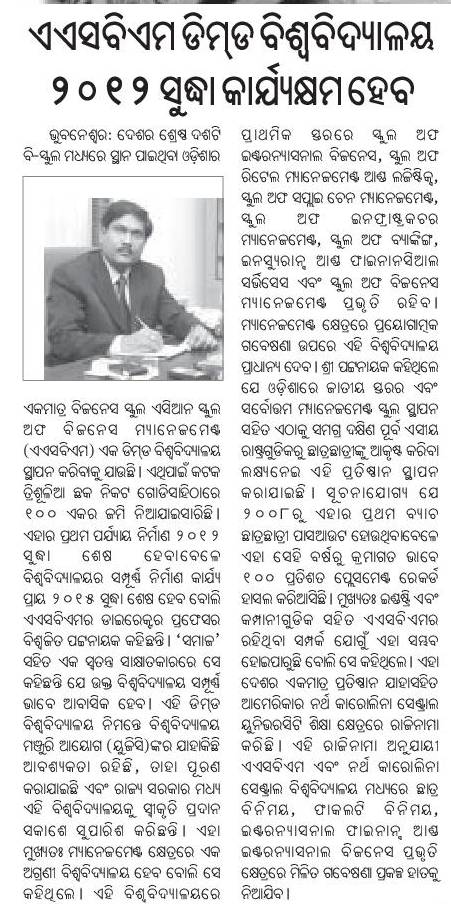
May 9th, 2009
Author : Chitta Baral
Following are from postings in the NISER orkut community about the NEST exam in the previous two years.
The pattern of NEST is somewhat as follows : The paper consists of 5 parts –
1. General, 2. Physics, 3. Chemistry , 4. Biology, 5. Mathematics
The General section is mandatory for all. Amongst the other 4, you are supposed to attend ANY 3. All sections carry equal weightage. Regarding the query about scientists and contributions, such kind of questions needn’t be expected in the NEST exam. It basically checks your analytical skill, reasoning and application of concepts. Hence, direct formulae, simple numericals etc. are less probable in NEST.
There will be questions with only one correct answer as well as more than one right alternative. As with the case of SPECIAL textbooks for NEST, your thorough knowledge of basic concepts will be your best guide in the exam, as it evaluates your ability to reason properly, apply your knowledge and arrive at the answer.
abt question types ,
hi ,
The previous year’s paper are not released in public domain yet . however i can assure u it is not like any engineering or medical competitive exam papers. The questions require more analysis and are more thought-provoking. n about books , i think ncert books plus some books with sound theoretical concept would help .
>>henry
analytical questions like, u might be given some graphs or a trend of any sort n u l need to answer based on wht u deduce frm it ( eg bacterial population growth , nuclei decay kind of ). i do not trhink u l need to hurry as in other exams but time management of course helps .
The question pattern ‘s a bit different from IIT-JEE, AIEEE or AIPMT. Here, you have a compulsory general section + 3/4 subjects(Phy,chem,bio,math) , & in each section you wil be having ten 3 mark questions n five (or was it six?) 5 mark questions, or atleast thats the way it used to be! The 3 mark qns wil hav only one right answer out of the given choices while the 5 mark ones wil hav more than one correct alternatives. Remember that the 3 mark qns wil fetch you a -1 if you get that wrong, but Heard that there wil b no -ve marking for the 5 mark ones. Heard that this time , the general section ‘s got as equal weightage as the other sections. And regarding some exact qns askd in previous xam, my poor memory doesnt help. Sid , Ishan – May be you can help ém out wid a qn or two.
Well, I dont think it’d be necessary for you to be a master of ‘history of science’ to answer d qns in general section successfully. There wont be any qn demanding the answer for "In which year did Roentgen invent the X-ray?" or "Who was the only woman to win the Nobel prize twice?". But for the general section, you need to hav a good ability to ‘think out of the box’ as Sid has mentioned, to be logical, to reason well, n here too, to be clear with your basic concepts. ‘Cos, tho d qns wont be about d years or names, it ‘d definitely help you if you know what ‘s d idea/concept/principle behind different famous classical experiments in science(like Millikan’s oil drop expt, Luria-Delbrook’s expt etc.)
nest 2007 questions.
i remember one or two questions.
1. given that hydrogen gas is at some volume V & pressure P. if the volume is tripled what would be its final pressure. the gas is kept in athermos flask.
2. place the order in which the following occured in time scale.
* darwin proposed his theory.
*kepler proposed his theory on planetary motion.
*there were two more, i dont remember.
3. there was also a question related to the topic critical temperature of real gases. how does the gas behave when it undergoes free expansion. helium gets heated up as its critical temperature for cooling is higher than the room temperature. a whole paragraph was given on this topic & 4 questions were asked in this in the general(compulsory ) section. this question was similar to unseen passage,.
About General Section
I got some questions of the general section from some of the present 1st year students of NISER. Last year there where 3 or 4 questions from the History of Science part like the year in which Einstein gave the concept of stimulated emission of light, and what Fermat’s last theorem states and what is the main observation in proof for the expanding nature of light.
In last 2 years NEST papers there where questions asking you to arrange the given events in the chronological order. Also as Ved have already said, there were 3-4 question which you should answer based on the paragraphs given above. Last year the paragraphs were about Fresnel and Young’s wave theory of light. And in the year before the paragraphs were about the critical temperature of gases.
Altogether there were 10 questions in the General Section.
@Şűќѓĩŧĩ
ya it was a mistake, i mean the expanding nature of Universe
>>Swati
To know abt the no: n type of qns,pls refer to previous posts.
For Biology, the biology questions of NEST-2007 were more of ‘checking the concept type’ than ‘checking the information type’. For e.g., there was a question in which a diseased condition called anhydrotic dyplasia was described and questions were asked based on the info provided( like"what if it was like this?". However, this may not be the case always. You are supposed to know the classical experiments, the key concepts, and the basic information, if which ‘s included in your syllabus (ie, informative knowledge of things in syllabus is also important. For e.g., if somebody asks you "How can you possibly reduce the risk of cardiac diseases?" to answer,you must know WHAT all factors lead to cardiac diseases).
However, cramming up lots of data aint gonna help you either. The concepts behind the experiments and the data are more important. So, in the li’l time left now, try to brush up the different concepts in biology ( I mean, for e.g, try to understand what leads to evolution more thoroughly than what are the different kinds of evolutionary evidences, or When you rewind Lederberg’s replica plating expt., try to figure out what they meant to prove by the expt, what was the reasoning etc. When you say Dihybrid ratio ‘s 9:3:3:1, think what did Mendel infer frm that ratio. ) . Such a kind of thinking can really help solve the biology questions n all NEST qns in general.
May 9th, 2009
Author : Chitta Baral
Following are excerpts from a report in tathya.in.
Professor Banerjee met the Orissa Chief Minister Naveen Patnaik here to apprise him the developments on the new varsity front.
She is clearly defensive and said that the campus will be at Koraput and classes will start in August next. …
During the meeting with Chief Minister, she made it clear that the Campus will be at Koraput.
She said that there seems to be some misgivings about the Second Campus at Bhubaneswar.
Prof. Baneerjee seems defensive and said that all out efforts are being made to start the Campus at Koraput.
Mr.Dasverma was outraged over the decision and demanded action against the people concerned.
Young NROs led by Digamabara Patra created huge stir in both the state and at national level.
Professor Patra wrote it to the Prime Minister, Minister HRD and Chief Minister.
More than 100 students, teachers, educationists and members of the civil society demanded immediate action by sending e-mails.
All of them demanded that if et al the second campus will be opened it should start at Bhawanipatna in Kalahandi.
The Chief Minister’s Office(CMO), was flooded with e-mails from all parts of the world and the mandarins were worried over the matter.
Bijay Kumar Patnaik, Principal Secretary to CM took up the matter seriously.
And Prof.Banerjee was summoned to clarify the factual position.
Madhu Sudan Padhi, Secretary Higher Education department, who did not buy the idea of Second Campus of CUO here, before starting the original campus at Koraput.
Mr.Padhi asked her to make arrangements in Koraput.
Prof. Banerjee is now under pressure to start classes at Koraput.
Following is from Samaja.
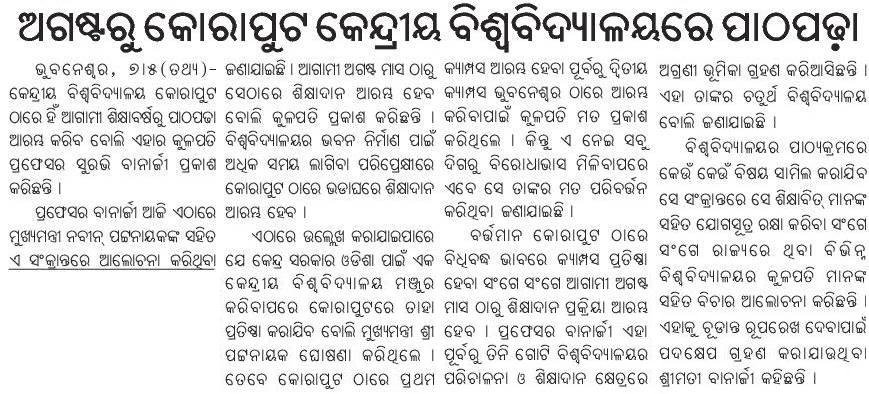
May 8th, 2009
Author : Chitta Baral
Following is an excerpt from a report in Expressbuzz.com.
Bangalore Medical College and Research Institution (BMCRI) will soon house the Regional Institute of Para-medical Sciences (RIPS), which is aimed at ensuring a steady supply of qualified paramedical staff in the state and across the country.
The proposed RIPS is one of the six such regional training centres proposed by the Centre to augment shortage of men in the health sector.The work on the two National Institute of Para-medical Centres at Najafgarh, Delhi and Chengalpet in Tamil Nadu is going on at brisk pace.The BMRCI already runs six courses in the paramedical discipline. “Once the RIPS starts, about 10 new courses will be introduced.
The institute will have a capacity of 1,000 students and the admission will be through the CET.In the line of IITs, IIMs and AIIMS, these institutions will become a model training institutions for paramedical education in the country.” said,Dr G T Subhash, Dean and Director, BMCRI.“
… According to an official estimated, there is 4.3 million shortage of para-medical staff world-wide with acute shortage in South-East Asian region.According to WHO report India needs to invest at least US$2 billion per annum to for the next six years. India faces a crunch of about 60-70 percent paramedical staffs, as the paramedical education system seems to be unorganised and as such there is no paramedical council and accreditation system. …
Paramedicals are persons trained to assist medical professionals in thediagnosis and treatment of patients. These includes:
â— Medical laborotory technologists, blood bank technologists.
â— Nurses, skilled birth attendants, operation theatre assistants.
â— Radiographers, radiotherapy technologists, perfusion technologists, ECG, EEG and EMG technologists.
â— Physiotherapists, occupational therapists, audiology and speech therapists, orthotists/ prosthetists.
â— Optometrists, pharmacists, clinical psychologists, pre hospital trauma technicians, dental mechanics, dialysis technologists and medical records technologists.
Besides the above, a Regional institute of Paramedical and Nursing Sciences (RIPANS) is already established in Aizawl and one is being tried in Kozhikode, Kerala. Following is an excerpt about the later from a news item in oneindia.in.
Kerala Health Minister P K Sreemathy today said the government was expecting a formal approval from the Centre for the proposed Regional Institute of Paramedical Sciences(RIPS) at the Kozhikode Medical College Hospital within three months.
Talking to reporters here, she said the government had allotted 25 acres of land for the purpose and the expert team, which inspected the site, had expressed satisfaction.
The institute, to be set up at a cost of Rs 90 crore, would conduct 57 new courses, she said and added that the project would be implemented as part of the second anniversary of the Left Democratic Front (LDF) Government in the state.
Ms Sreemathy said the Health Department would start three nursing colleges in Malampuzha, Uduma and Pallurthy and the government was waiting a formal approval from the Medical Council.
Why is not Orissa pursuing one of these?
May 7th, 2009
Author : Chitta Baral
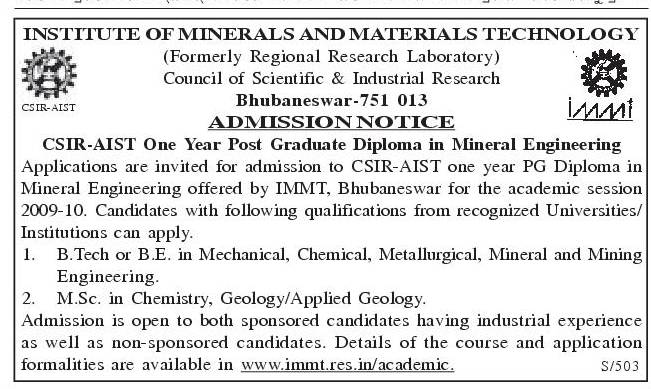
The details of the course is at http://www.immt.res.in/academic/. It looks like a very good program to pursue and should lead to jobs in the various mining and mineral processing plants (including steel and aluminum plants) in Orissa. Following is the program structure.
Duration : The PG Diploma programme will be of one year duration, consisting of two semesters. Both theory classes and practical demonstrations will be taken up during the 1st semester for six courses. During the 2nd semester, the students will be carrying out project work.
1st Semester:
Theory:
| Subject Code |
Subject Title |
| ME-01 |
Characterisation Techniques |
| ME-02 |
Comminution, Classification & Agglomeration |
| ME-03 |
Separation Processes |
| ME-04 |
Surface Phenomena & its Application |
| ME-05 |
Environment & Waste Treatment and Corporate Social Responsibility |
| ME-06 |
Computer Application in Mineral Processing |
Practical Demonstration:
| Mineralogical characterisation |
Agglomeration |
Magnetic Separation |
Jigging |
Fluidisation |
| Comminution |
Dewatering |
Specific Area Measurement |
Tabling |
Electrostatic separation |
| Size separation |
Flotation |
Pychnometry |
Process Simulation |
Fine particle separation |
2nd Semester:
PROJECT WORK & PROJECT REPORT SUBMISSION
Project work to be carried out either at IMMT for students enrolled in ‘non-sponsored’ category or at respective industries for students enrolled in ‘Sponsored’ category.
May 5th, 2009
Author : Chitta Baral
Following is an excerpt from a report in tathya.in.
Professor Faizan Mustafa has taken over as the first Vice Chancellor (VC) the National Law University of Orissa (NLUO) today. …
Dr.B S Chauhan, Chief Justice of Orissa High Court and Chancellor of the University approved and accepted his appointment here on 2 May. …
Dr.Chauhan has also instructed the VC to admit students from the next academic session i.e. 2009-2010.
An admission advertisement would be released soon, said official sources.
Prof.Mustafa after taking over as the VC on 2 May, he said that he would try his best to prove worthy of confidence reposed in him and would leave no stone unturned in establishing a World Class Law University at Cuttack.
The focus of new Law University would be “Justice Studies” rather than traditional “Legal Studies” and Mining Law, Water Law, Shipping Law, Food Law and Agriculture Law would receive special attention, said VC of NLU, Orissa.
May 4th, 2009
Author : Chitta Baral
As per http://nest.niser.ac.in/choosecentre.php the number of students registered for NEST and their centers are:
- Ahmedabad: 168
- Allahabad: 285
- Bengaluru: 174
- Bhopal: 577
- Bhubaneswar: 3303
- Chandigarh: 413
- Chennai: 418
- Dehradun: 165
- Delhi: 1458
- Guwahati: 159
- Hyderabad:727
- Jaipur: 653
- Jammu: 61
- Kochi: 539
- Kolkata: 1192
- Lucknow: 841
- Mumbai: 837
- Nagpur: 270
- Panaji: 25
- Patna: 830
- Raipur: 262
- Ranchi: 526
- Sambalpur: 248
- Shillong: 17
- Simla: 38
- Srinagar: 14
The total is 14,200. (Last year 8,000 appeared NEST.) The total number of seats that are available this year are 52 in NISER and 30 in UM-DAE.
May 2nd, 2009
Author : Chitta Baral
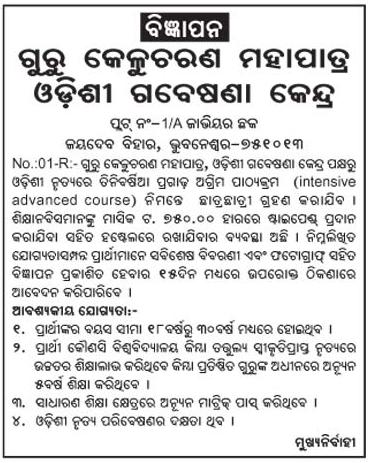
April 27th, 2009
Author : Chitta Baral
The tathya.in article is at http://www.tathya.in/2009/story.asp?sno=2873. Following are some excerpts:
… now its officials were not in a mood to go to the tribal dominated district.
The reason: lack of facilities like airport and modern health care units.
Surabhi Banerjee had been appointed as the first vice-chancellor of the central university at Koraput.
But, Prof. Banerjee, is in no mood to move to Koraput.
Sources said, the VC had been persuading the state government officials to open temporary campus of the varsity in the state capital instead of going to Koraput.
The newly formed central university authorities claimed that the academic activities could begin from temporary campus here till the building was constructed at Koraput.
By the time, the building would be over; Prof Banerjee’s term could end.
The Samaja article is as follows:

Considering the lack of higher education opportunities in KBK and Koraput, the Central University should be started, even in the short term, from Koraput. I am sure some rented accommodation and quarters can be obtained in the nearby Damanjodi and Sunabeda townships. In the worst case, if something is done in Bhubaneswar, under absolutely no circumstances, it should go beyond one year. The Vice Chancellor should plan to move to Koraput as soon as possible, and under no circumstances, should stay outside of Koraput, beyond a year. Otherwise, perhaps she can move to another university and CUO Koraput is assigned a new VC who is not averse of staying in Koraput.
Finally, even if the goal is to have multiple campuses of the central university across the state, there is no need to have one in Bhubaneswar. The second and other campuses should be established in KBK and other areas of Orissa which lack universities. The Bhubaneswar area has many universities and a National University is about to be established there too. So there is absolutely no need to have a campus of the Central University of Orissa (Koraput) in Bhubaneswar.
April 26th, 2009
Author : Chitta Baral
The web page of ZEE Institute of Creative Arts is http://www.zica.org.There head office is Mumbai and as per their "Contact Us" page it currently has two campuses in Mumbai and Bhubaneswar. Following is an excerpt from a news Item in Express Buzz about the opening of their Bhubaneswar Campus.
Adding another feather to Capital’s list of institutions offering career-oriented professional courses, Zee Institute of Creative Arts (ZICA) today opened its centre here at Niladri Vihar.
With animation industry in India poised to grow at 27 per cent to reach a 1,163 million dollar mark by 2012, the institute hopes to provide affordable animation courses to cater to the manpower demands when Bollywood alone plans to make another 12 feature films based on animation and special effects. Also the gaming industry is all set to grow rapidly with a huge demand of professionals.
Addressing mediapersons, Head, Youth Business, Zee Learn, Subhadarshi Tripathy said as traditionally Orissa has many well-known animation artists engaged at the national level, ZICA thought it appropriate to open its second centre outside Mumbai here so that students from the entire Eastern Indian states can be given an opportunity to learn the art and equip themselves to take various career opportunities in film making, visual effects, television production and advertising industry.
‘‘ZICA, which first started in Hyderabad way back in 1995, was later shifted to the Esselworld campus in Mumbai and has become the pioneer animation institute with its distinct training style and approach towards industry-oriented curriculum’’, he said adding, however, to maintain quality it never ‘‘opened branches elsewhere outside the city of dreams’’.
The local centre will impart a two-year diploma in animation film making and one-year course in digital arts, but later would also introduce short-term courses. ‘‘While the two-year course would need an investment of around Rs 3 lakh, the short-term ones may vary from Rs 40-75,000’’, he said adding, compared to Mumbai, the local centre will be more affordable with the same standard of teaching and infrastructure facilities.
‘‘For each course there would be a six-faculty team apart from industry professionals as guest faculty and the teacher-student ratio would be around 1:4’’, he pointed out. …
April 25th, 2009
Author : Chitta Baral
Following is an excerpt from a report in expressbuzz.com.
For an architect, it is always challenging to incorporate elements of local art and culture into modern day structures. But, if the words of leading health-care planner and architect with ‘Perkins+Wills’ Nick Seierup are to be believed, the interiors of the proposed Vedanta University Hospital on Puri-Konark Marine Drive would be an example of amalgamation of ethnicity and modernity keeping in mind local needs and aesthetics.
…‘‘As an institution of inter-disciplinary studies the proposed design of the six-storeyed structure will have an ultra modern look and will equip the students and researchers of the medical facility to have enough space for interactive learning through open-air or enclosed surroundings with eco-friendly atmosphere’’, he added.
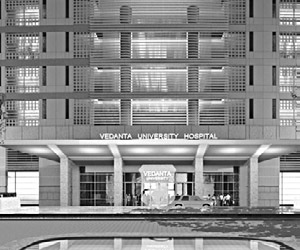
April 11th, 2009
Author : Chitta Baral
Next Posts
Previous Posts







